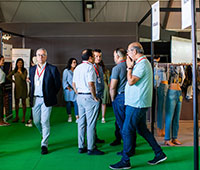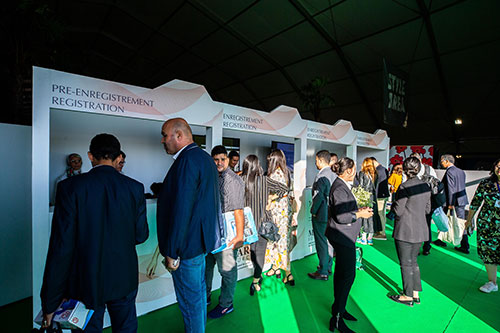FW
ColorJet India, one of India’s largest manufacturers of digital textile printing technology, plans to expand its operations in China to derive volume growth in the world's largest textile market.
As per an IDC suggested report, ColorJet, with more than 33 per cent market share in the super-wide format digital ink printers in India, commands absolute leadership in the world’s third-largest textile exporting and fifth-largest garment exporting country in the world.
The Chinese textile market, currently estimated at US$ 230 billion, is expected to reach US$ 400 billion by 2022. ColorJet targets to capture 5-7 per cent of the pie, looking at the vast potential market of super wide format digital ink printers. ““Order volumes this year have been exceptionally strong, so we look forward to continuing the momentum by having live systems running at ShanghaiTex. China is the biggest market and we look forward to make our presence felt in China,” said Jitender Pal, Singh, Vice President-Textile of the brand. “We aim to capture 5-7 per cent of the digital inkjet printer market in China in the coming years. With our existing product lineup, we provide more sustainable and efficient solutions that deliver maximum productivity as compared to its nearest competitor,” he added.
"This year, Maroc in Mode focused on sustainable aspects and fast fashion in line with the visitors' interest. Increasingly more exhibitors into sustainability certified, i.a. from Oekotex, BSCI, GOTS, ISO, through individual customer audits, etc. Exhibitors and visitors unanimously confirmed that sustainable production is the textile future. The signage of the partnership agreement with France, UIT - Union of Industries Textiles and UFIMH - Union Francaise Mode & Habillement - was a further step towards internationalisation of the show."
 This year, Maroc in Mode focused on sustainable aspects and fast fashion in line with the visitors' interest. Increasingly more exhibitors into sustainability certified, i.a. from Oekotex, BSCI, GOTS, ISO, through individual customer audits, etc. Exhibitors and visitors unanimously confirmed that sustainable production is the textile future. The signage of the partnership agreement with France, UIT - Union of Industries Textiles and UFIMH - Union Francaise Mode & Habillement - was a further step towards internationalisation of the show. The new association structure of AMITH will work intensively on further innovations for the trade fair and the Moroccan textile industry.
This year, Maroc in Mode focused on sustainable aspects and fast fashion in line with the visitors' interest. Increasingly more exhibitors into sustainability certified, i.a. from Oekotex, BSCI, GOTS, ISO, through individual customer audits, etc. Exhibitors and visitors unanimously confirmed that sustainable production is the textile future. The signage of the partnership agreement with France, UIT - Union of Industries Textiles and UFIMH - Union Francaise Mode & Habillement - was a further step towards internationalisation of the show. The new association structure of AMITH will work intensively on further innovations for the trade fair and the Moroccan textile industry.
The event witnessed more than 140 participants this year with increasing international exhibitor’s also large number of production specialists presenting themselves. The event covered 1,000 trade visitors at the Moulay Hassan racetrack in Marrakech. Visitors from 16 countries, such as Spain, France, Portugal, Italy, UK, Germany, etc., including high-profile companies and vertical top providers used the show as a platform to expand their product portfolio, intensify existing contacts and finalise production projects.
number of production specialists presenting themselves. The event covered 1,000 trade visitors at the Moulay Hassan racetrack in Marrakech. Visitors from 16 countries, such as Spain, France, Portugal, Italy, UK, Germany, etc., including high-profile companies and vertical top providers used the show as a platform to expand their product portfolio, intensify existing contacts and finalise production projects.
With more than 185,000 employees, textile industry is the largest industrial employer in Morocco. The industry accounts for a quarter of national exports, and in 2018 Morocco exported goods worth € 3.6 billion. Among the Mediterranean countries, it is on number two in terms of exports to the EU, ranks seventh overall among the major suppliers of textiles and clothing to the EU. The more than 1,600 companies have an annual production capacity of 1 billion parts. Morocco to develop all-around solution provider adjectives focusing on internalization strategic development plans.
The Hong Kong Research Institute of Textiles and Apparel has collaborated with Gap Inc to develop eco-friendly production processes and technology solutions that enable the industry to move from a linear model to a circular model across the life-cycle of textiles. The institute has identified two initial research areas that include separation of spandex from used garments and denim decolourisation for recycling.
The textile industry is currently unable to separate spandex in an eco-friendly and circular way from blended fabrics, such as cotton-spandex blend. The research project, which sees HKRITA partnering with creative textile manufacturer Artistic Milliners, is being designed to develop an eco-friendly separation method that removesspandex using bio-solvents. In this way, the separated materials can be re-used by the textile industry.
The research area will also tackle denim decolourisation, a long-standing problem in the textile industry. Currently, common industry practice involves chemical treatment, but this method can harm fabric properties and create negative environmental impacts. This project will also join hands with leading denim manufacturer Arvind Limited to develop a physical method to decolor the denim so that the cotton can be more easily reused or re-dyed.
"KPMG along with Fashion Summit and HSBC recently released a new report titled ‘Sustainable Fashion: Committing to a Sustainable Future Through the Fashion Industry Charter for Climate Action’. Released to coincide with the commencement of the Fashion Summit 2019 held recently in Hong Kong, the report stated though companies have been incorporating sustainability initiatives in their operations for a long time, lot still needs to be done to achieve a truly sustainable fashion industry."
 KPMG along with Fashion Summit and HSBC recently released a new report titled ‘Sustainable Fashion: Committing to a Sustainable Future Through the Fashion Industry Charter for Climate Action’. Released to coincide with the commencement of the Fashion Summit 2019 held recently in Hong Kong, the report stated though companies have been incorporating sustainability initiatives in their operations for a long time, lot still needs to be done to achieve a truly sustainable fashion industry.
KPMG along with Fashion Summit and HSBC recently released a new report titled ‘Sustainable Fashion: Committing to a Sustainable Future Through the Fashion Industry Charter for Climate Action’. Released to coincide with the commencement of the Fashion Summit 2019 held recently in Hong Kong, the report stated though companies have been incorporating sustainability initiatives in their operations for a long time, lot still needs to be done to achieve a truly sustainable fashion industry.
Less than 15 per cent companies surveyed in the KPMG report stated their supply chain-related greenhouse gas (GHG) emissions help them to formulate better climate strategies. This is mainly due to the fact that measuring these GHG emissions is a complex process and can prove to be a big challenge for many signatories.
Increased awareness with sustainable operations, products
The KPMG report reviews the publicly available information on sustainability performance of 43 signatories of the UN’s Fashion Industry Charter for Climate Action, including their sustainability reports and corporate websites. One of the key findings is that brands still need to enhance their consumers’ awareness on sustainability. Around 60 per cent brands surveyed had a section on sustainability on their consumer websites while around 35 per cent had a sustainable product line.
the UN’s Fashion Industry Charter for Climate Action, including their sustainability reports and corporate websites. One of the key findings is that brands still need to enhance their consumers’ awareness on sustainability. Around 60 per cent brands surveyed had a section on sustainability on their consumer websites while around 35 per cent had a sustainable product line.
Some signatories also strive to raise their consumer’s sustainability awareness by publicly disclosing their initiatives on various e-commerce channels. Of the signatories, 67 per cent brands made their sustainability data available in either their sustainability reports or annual reports, while 93 per cent had a sustainability section on corporate websites.
Transparency aids sustainability in fashion brands
Further, the Sustainable Fashion report states, in order to help consumers make responsible decisions brands need to make information about products, sourcing and environmental impact, accessible to all buyers. They also need to create a new sustainability labeling system that would encourage consumers to purchase sustainable fashion.
One of the ways brands can achieve this is by leveraging existing tools and standards such as the Sustainable Apparel Coalition formed in 2011, and the Higg Index, and Kering’s Environmental Profit & Loss (EP&L) account. The industry has developed these tools through many years of efforts. Now, brands need to leverage their potential to create a tangible impact.
The Cotton Textile Export Promotion Council (Texprocil), reported a 38.8 percent decline in the value of India’s cotton yarn exports, at $1.28 billion between July and September 2019, from $2.09 billion in the corresponding period last year. Cotton yarn exports have been steadily declining month after month this year, in volume terms, from 90 million kg in April to 67 million kg in September.
By contrast, demand for polyester yarn and fabric increased as these products are much cheaper than cotton. Industry estimates polyester to be 40-50 percent cheaper than cotton across all variants. Profitability of Indian polyester yarn manufacturers has been growing steadily. This is primarily on account of the rise in consumption of synthetic yarns across the world, as compared to natural fibers. Moreover, the cost competitiveness of Indian manufacturers has been better than that of Northeast Asia manufacturers, which has resulted in better operating margins and profitability.
In India, demand for polyester fibers has been growing strongly, led by steady consumption from textile firms. Moreover, domestic manufacturers of polyester yarns have been able to increase their capacity utilisation as the anti-dumping duty imposed on China led to a pick-up in domestic demand compared to imported yarns.
José Luis Martínez de Larramendi, current head of Primark in the American market will lead the expansion in the new markets. He will also be in charge of the US. Primark signed him in 2009 to lead the chain’s growth in the Portuguese and Spanish market. Larramendi has more than 20 years of experience in the fashion business. The executive began his career at C&A, where he worked for 10 years and held positions such as commercial and human resources management in Spain and Portugal.
After five years in the Spanish subsidiary, Primark entrusted him with a new leap forward: landing in the American market, where the company opened its first store in Boston in 2015. At the end of the last fiscal year, ended on September 15 2018, Primark operated with nine stores in the country.
Martínez de Larramendi will be in charge of running the arrival of the group in a new market, Eastern Europe. Primark has opened in Slovenia this year, its 12th global market, with a store in Ljubljana. Before the end of the year, the company also plans to open its first store in Poland, that will be located in the Galeria Mtociny shopping center in Warsaw, and by 2020 it will arrive in the Czech Republic with an opening in Prague.
German fair organiser Panorama has launched a new pop up concept called Brand Village in which the company will exhibit a selection of brands in different cities in Germany at different times of the year. The group, which has just moved to Berlin Tempelhof, has changed its format with the launch of a new strategy. The first of these changes will take place in the January 2020 edition, where the group will have its 10,000 square meters’ space, Brand Avenue, where each brand will control its own space and focus on its products.
Through these changes, the group aims to bring fashion to the final customer. The movement is a part of the group’s strategy to reactivate the fair, which in recent editions has been losing strength. Panorama will not be the first fair with an itinerant concept. In its latest editions, Denim Première Vision has been held in different cities such as London or Milan.
Mango, along with 23 other companies from the textile and fashion sector, has signed the Fashion Pact, which aims to minimise the environmental impact of the textile and fashion industry by focusing on three key areas; climate, biodiversity and oceans. Signing the pact is part of Mango’s commitment to make environmental sustainability one of its core strategies. In this regard, the company carries out all its daily activities by adopting environment-friendly and sustainable development criteria in all areas of its business.
The Fashion Pact will set out actions to be carried out in the coming years through the agreements entered into, which will allow us to move forward collectively in favor of sustainability and to the benefit of the entire industry. The global pact commits all its signatories to work collectively to minimise the environmental impact of the textile and fashion industry by focusing on three key areas: fighting against climate change, preserving biodiversity and protect the oceans.
Karl Mayer invited leading global textile industrialists and international investors in Vietnamese textiles industry to participate in a joint exclusive recently. Around 90 participants from 13 countries attended the event. Most guests came from Vietnam, Korea, Taiwan and China. And some of them undertook the journey from Europe.
With exports worth $36.2 billion, 2018 was the most successful year for the Vietnamese textiles and clothing industries. Considering the trade war between China and the US, the year 2019 brought both chances and challenges for Vietnam. In the first six months, the sector’s exports to the US increased by 29 per cent. Sales revenues in the US market amounted to around $7 billion. This represents 46 per cent of the total revenues.
The country has high exports but low imports. To reduce the surplus, US President Donald Trump threatened to impose punitive tariffs on Vietnamese products at the G-20 Summit in June 2019. Additional levies would have a great impact on the Vietnamese economy, because the US is the most important market for this Asian country.
The government plans to amend the Micro, Small & Medium Enterprises Development Act to allow it to change the definition of a MSME to one based on turnover. This move could allow more businesses to register as MSMEs and be eligible for certain government schemes. The Union Government has been promoting the MSME sector and believes that it will lead the next phase of India’s economic growth.
The new government proposal would classify a MSME as a business with an annual turnover up to Rs 5 crore ($752,000) and businesses with up to Rs 75 crore annual turnover as a “small unit”. Businesses with up to Rs 250 crore in annual revenue would be classed as “medium scale” businesses. The MSME Ministry is currently finalising the proposal. As many handicraft, artisan, textiles, and fashion businesses’ revenue amounts to Rs 5 crore or less annually, the proposed definition could have a bearing on how such businesses are classified.












